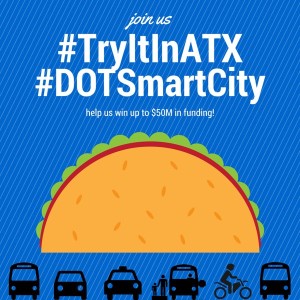 With Mayor Adler and Austin transportation officials in DC today in connection with the city’s bid as a finalist for the DOT’s Smart City Challenge, we wanted you to get a quick rundown on the latest coverage of this topic.
With Mayor Adler and Austin transportation officials in DC today in connection with the city’s bid as a finalist for the DOT’s Smart City Challenge, we wanted you to get a quick rundown on the latest coverage of this topic.
“What the Smart City Challenge Means for Austin now and Long-Term”
by Matt Glazer, executive director of the Austin Young Chamber of Commerce
https://www.austinyc.org/smart-city-challenge-means-austin-now-long-term/
When fully implemented, these technological advancements would provide greater opportunities that are now limited by access to having a working car—not to mention the time to navigate our clogged roads. But here’s the best part, and I was pretty excited to hear this myself: Austin is already doing all these things.
In some form, every one of those transportation transformations is already underway in Austin. The City of Austin just partnered with the University of Texas at Austin on a big data project. Google is testing driverless cars in our neighborhoods, and General Motors and Lyft are exploring driverless ridesharing. And the City’s transportation department has been working towards linking all mobility options to Park & Ride centers.
“Austin: Wonderful, Wired and Weird”
by Yasmin Galal, Progrss
http://progrss.com/places/20160405/austin-wonderful-wired-and-weird/
Meanwhile, Austin is competing for a fund of $40 million from the US Department of Transportation’s Smart City Challenge to create the first-of-its-kind modern transportation system. The city’s pitch included bold innovations to replace carbon-based fuel consumption with climate-friendly vehicles and technologies that link people to transport information in ways that will improve quality of life and lower greenhouse gas emissions.
Winning this challenge would be another important accolade for Austin that shows the city’s undying commitment to innovation to solve communal urban problems. Austin, despite its well-designed downtown, holds a mid-low ranking in terms of walkability (35th in the US) and can use this challenge to enhance its infrastructure and help diminish the East/West divide. It will also serve as a model smart city for other cities in the US and, given Austin’s great strides in engaging both the public and the private sector in decision-making, it’s easy to see how it will live up to this role. If anything, Austin was built to inspire.
“‘Smart cities’ tap technology as remedy for inequity”
by Ariel Wittenberg, Greenwire
http://www.eenews.net/stories/1060034941
In Austin, Texas, lax planning spanning decades resulted in a lack of low-income housing within the city, pushing minimum-wage workers into suburbs and exurbs outside the jurisdiction of Austin Public Transit.
In a region that lacks a multiregional train system, low-wage workers who live in the suburbs and work in the city must drive to work, Austin Transportation Director Robert Spillar said. And because of the way Texas structures its regional transit authorities, he said the city is not allowed to provide bus service to the suburbs.
That could change if Austin wins the Smart City Challenge with a proposal to develop “travel access hubs” in the suburbs where it would help set up a new kind of ride-sharing program.
“Potential UT, City partnership to research ways to improve transportation issues, community concerns”
by Forrest Milburn, The Daily Texan
http://www.dailytexanonline.com/2016/04/04/potential-ut-city-partnership-to-research-ways-to-improve-transportation-issues-community
When applying for the Smart Cities Challenge, Mayor Steve Adler wrote in the cover letter that the city is in need of the ability to use technology and innovation in solving its transportation issues — issues that both the Smart Challenge and the City’s potential MetroLabs membership could help address.
“Austin is a magnet for venture investment in research, tech, advanced manufacturing and the creative class,” Adler said in the letter. “Yet a huge swath of our community is struggling to pay for housing and transportation — and that’s unacceptable.”
